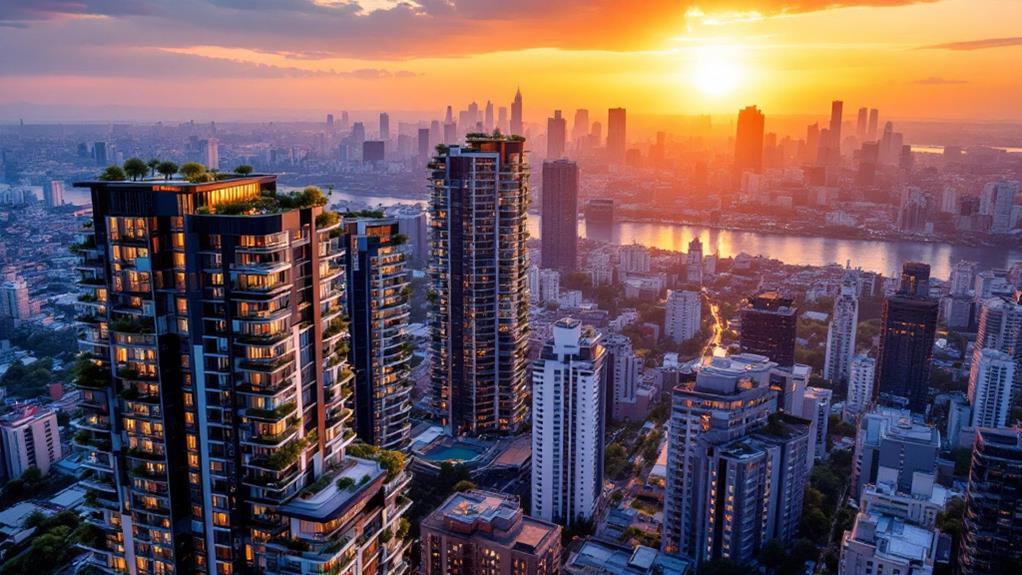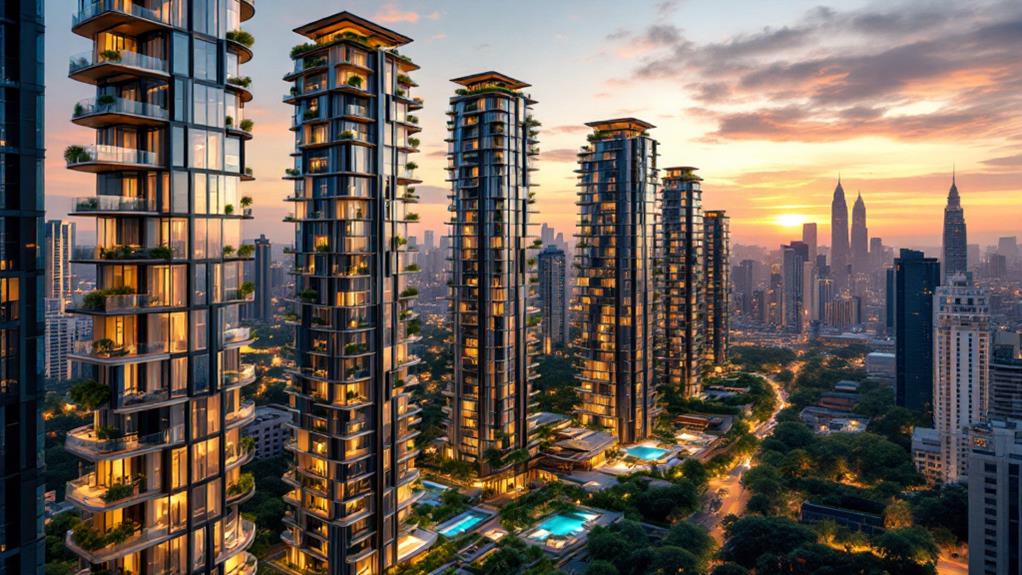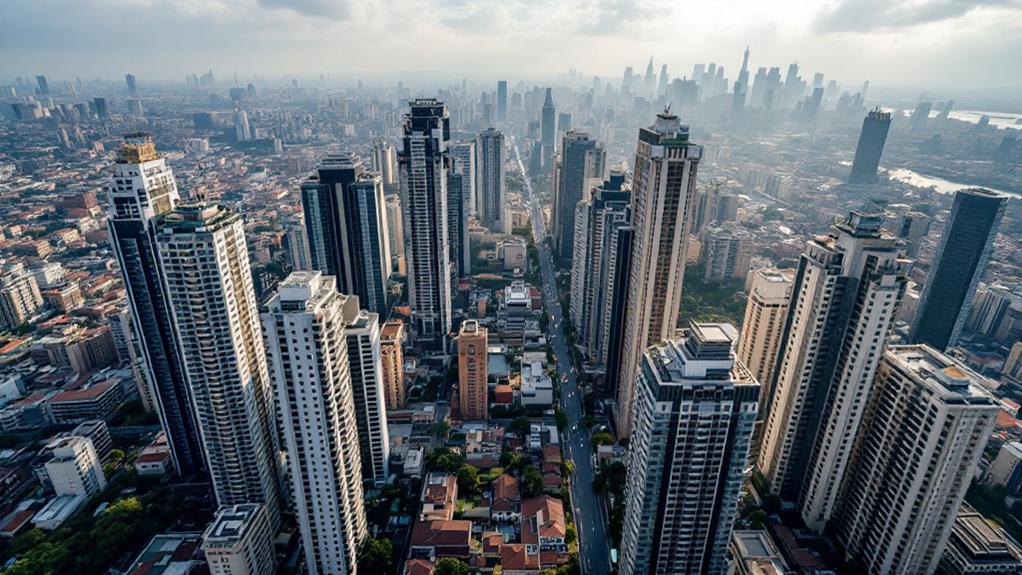The Largest Residential Buildings in the World

When exploring the largest residential buildings globally, you'll encounter incredible feats of architecture. Central Park Tower in NYC stands as the tallest at 1,550 feet. The Regent International in China holds a different record, housing over 20,000 residents. South Africa's Ponte City features a unique cylindrical design, while Dubai's Princess Tower was once the tallest. Oscar Niemeyer's Edificio Copan in Sao Paulo accommodates about 5,000 residents in its iconic shape. As urban living evolves, these giants offer insights into modern architectural trends and community lifestyles. Uncover how these structures shape urban landscapes and redefine city life.
Architectural Giants Around the Globe
Amidst the skyline of lively cities, architectural giants rise as symbols of human ambition and innovation. When you look at these modern marvels, you're witnessing not just impressive feats of engineering, but also homes for thousands. You're standing before the Central Park Tower in New York City, the tallest residential building in the world. This towering structure reaches 1,550 feet and offers luxury residences that redefine urban living, with prices ranging from $6.9 million to over $63 million.
Travel to Qianjiang Century City in China, and you'll find The Regent International, the world's largest residential building by capacity. It stands at 675 feet tall with 39 stories, housing over 20,000 residents. It's a demonstration of modern architecture's ability to accommodate large populations in a single building.
In Johannesburg, Ponte City impresses with its unique cylindrical design, towering at 567.6 feet. As Africa's tallest residential building, it accommodates about 3,000 residents. Meanwhile, Dubai's Princess Tower, once the tallest residential building from 2012 to 2015, showcases the city's futuristic skyline at 413.4 meters. Each of these buildings reflects the ingenuity and ambition of modern residential architecture worldwide.
Evolution of Residential Skyscrapers
Residential skyscrapers have dramatically reshaped urban landscapes over the past two decades. You've probably noticed the surge of residential towers piercing city skylines. This evolution began in the early 2000s, when constructing these towering giants started gaining traction. The Council on Tall Buildings and Urban Habitat (CTBUH) began tracking this trend in 2000, marking a new period for urban living. The Belchers Tower 1 & 2 in Hong Kong, standing at 221 meters, set the initial benchmark. Soon after, the race to claim the title of the tallest building intensified.
- 2000: The Belchers Tower in Hong Kong became the tallest residential building.
- 2012: Princess Tower in Dubai surpassed previous records at 413.4 meters.
- 2014: New York City's 432 Park Avenue reached 425.7 meters.
- 2020: Central Park Tower in NYC claimed the title at 472 meters.
- Trend: Increase in buildings over 200 meters reflects a shift to high-density living.
Noteworthy Buildings and Their Features

Among the most remarkable residential buildings around the globe, Regent International in Qianjiang Century City, China, stands out as the largest, with its impressive height of 675 feet and 39 stories that house over 20,000 residents. This towering building exemplifies modern residential architecture, combining vast scale with functionality. You can imagine the community dynamics within such an immense structure.
Moving to Africa, Ponte City in Johannesburg captures your attention with its unique cylindrical design. At 567.6 feet, this tower is the tallest residential building on the continent, boasting 55 stories. Its iconic shape not only defines Johannesburg's skyline but also serves as a striking example of groundbreaking residential design.
In Dubai, the Princess Tower once held the title of the tallest residential building from 2012, reaching a staggering 1,356 feet with 763 units. This skyscraper epitomizes luxury living in the heart of a vibrant metropolis.
Meanwhile, Edificio Copan in Sao Paulo, designed by the renowned Oscar Niemeyer, stands out for its architectural flair, housing about 5,000 residents across 38 stories. Likewise, Le Lignon in Geneva offers a solution to housing shortages with its 2,780 units spread across two massive buildings, accommodating over 6,000 residents.
Community Life in High Rises
As you investigate the grandeur of these architectural marvels, the focus shifts to understanding the lively community life thriving within their towering walls. In tall buildings like Regent International in China, you'll find a self-contained community that accommodates thousands of residents. The active urban lifestyle is supported by a variety of amenities such as shopping centers, restaurants, schools, and recreational facilities. These features foster a strong sense of community and encourage neighborly interactions.
Living in such a high-rise environment provides a unique experience akin to residing in a small town. Here, organized social activities and events boost resident engagement and forge connections among neighbors. However, the high density of living does present challenges, particularly with shared facility pressures like elevators and emergency access. Efficient infrastructure and community management strategies are essential to overcoming these hurdles.
Consider these aspects of community life in tall buildings:
- Diverse demographics create a rich cultural tapestry.
- Amenities provide convenience and foster social bonds.
- Events and activities strengthen community ties.
- Shared experiences lead to lasting friendships.
- Challenges require creative solutions and cooperation.
Living in these towering communities is more than just residing; it's about embracing a lively lifestyle.
Economic and Social Impacts

High-rise residential buildings like Regent International aren't just architectural feats; they greatly improve local economies and social landscapes. With over 20,000 residents, Regent International stimulates economic growth by drawing businesses and services to the area. This influx creates job opportunities, not only through construction and maintenance but also by supporting local businesses that cater to the daily needs of such a large population. As these buildings fill up, they provide vital housing solutions, easing urban housing shortages and raising property values in the vicinity.
However, high occupancy can strain shared facilities, impacting residents' quality of life and complicating emergency responses. It's important to manage these pressures effectively to maintain a harmonious living environment. But on the brighter side, large residential communities foster lively social environments. At places like Regent International, community events bring neighbors together, improving interactions and promoting a strong sense of belonging. These events can considerably enhance residents' well-being, making life in such towering complexes more enjoyable.
Ultimately, while challenges exist, the economic and social contributions of high-rise residential buildings like Regent International are undeniable, offering solutions and growth opportunities in urban settings.
Future Trends in Urban Living
Frequently, the future of urban living hinges on groundbreaking architectural designs and sustainable solutions. As cities grow, the trend of constructing the tallest residential buildings continues, with projects surpassing 300 meters planned worldwide. These towers not only address housing shortages but also redefine luxury residential living. By offering exclusive amenities and stunning views, they cater to affluent individuals seeking high-end lifestyles. Urban living solutions now focus on high-density developments that integrate amenities and services, creating self-contained communities that improve residents' experiences. Projects like Regent International in China exemplify this trend, blending convenience with lifestyle advancements.
Innovative designs emphasize energy efficiency and green spaces, vital for the quality of life in dense urban environments. Luxury residential towers, such as New York's Central Park Tower, highlight this shift towards sustainable architecture and high-end living, attracting discerning buyers and investors. As urban populations rise, the demand for enhanced infrastructure and public services grows, prompting discussions about adaptable living solutions for evolving demographics.
- Adopt high-density, mixed-use developments for effective urban living.
- Incorporate sustainable architecture focusing on energy efficiency.
- Integrate green spaces to improve urban residents' quality of life.
- Develop luxury residential towers with exclusive amenities.
- Guarantee infrastructure keeps pace with rising urban populations.



